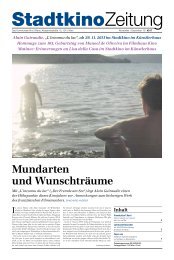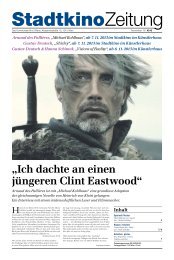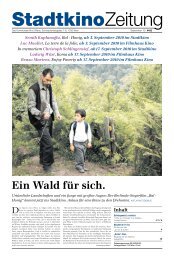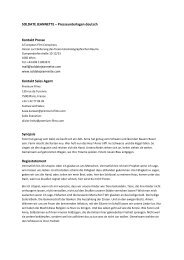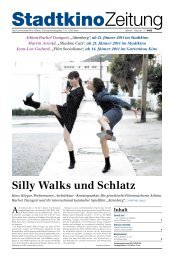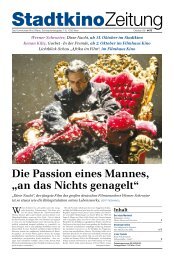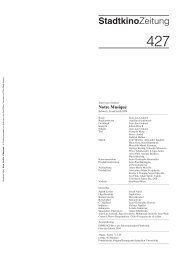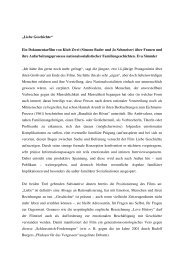Presseheft deutsch englisch - Stadtkino Wien
Presseheft deutsch englisch - Stadtkino Wien
Presseheft deutsch englisch - Stadtkino Wien
You also want an ePaper? Increase the reach of your titles
YUMPU automatically turns print PDFs into web optimized ePapers that Google loves.
Shirley – Visions of RealityFriday, August 28 th 1959, Cape Cod, 11 a.m.Ja. Es ist unglaublich, mit welchen Dimensionen er arbeitete. Oft sind Betten dreiMeter lang, dann gibt es wieder so enge und schmale Fauteuils, dass man kaumdarin sitzen kann. Man musste überlegen, welche Elemente bespielt werden, wasvon den Vorgaben praktikabel ist und was nicht. Was nicht benutzt wird, kann manauch so bauen, dass es so aussieht als ob, ohne dass es funktionieren muss.Und alles ist anamorphotisch, kein Möbel im rechten Winkel, kein Raum orthogonal.Vor welche Aufgaben stellte Sie das Licht?Das Licht ist neben den Figuren ein weiterer Hauptdarsteller, es erforderte ebensoviel Aufmerksamkeit wie die Inszenierung der Schauspieler oder die Farbgestaltungdes Sets. Die Lichtsetzung dauerte ungefähr genauso lange, wie dann die Drehzeitausmachte, cirka einen bis eineinhalb Tage. Jerzy Palacz der Kameramann und DominikDanner der Oberbeleuchter arbeiteten an der Umsetzung der Licht und SchattenweltHoppers seit dem Pilotfilm. Auch sie waren davon besessen, die Darstellung desgemaltes Lichtes so getreu und nahe an dem Hopper-Bild wie möglich umzusetzen.Bei manchen Bildern stießen wir an die Grenzen der Machbarkeit und wir warenpermanent vor Fragen gestellt – was wollen wir zulassen? Was nicht? Wirft unsereHauptfigur, wenn sie vor dem Fenster steht, einen Schatten oder nicht? Wie machenwir es glaubhaft, selbst wenn es nicht dem Hopper-Bild entspricht. Unsere Arbeitmusste ja auch im filmischen Sinn glaubhaft sein, so wie ein Hopper-Bild als Gemälde.Blieben die Kameraeinstellungen in der Totalen?Nein. Mindestens ein Frame stimmt im Laufe jeder Episode in der Totalen exaktmit dem Hopper-Bild überein. Wir durften die Kameraposition nicht verlassen, auchWhat was the challenge regarding the lighting?Lighting plays a major part, not unlike the characters, requiring as muchattention as the mise-en-scène of actors or the colour design of the set.The lighting design took up as much time as the shoot, about one to one anda half days. Jerzy Palacz, the cinematographer, and Dominik Danner, the gaffer,worked on the realization of Hopper’s world of light and shadows, ever sincewe shot the teaser. They were also obsessive in their endeavour to recreate thepainted light in Hopper’s picture as accurately as possible. With some pictureswe were stretching the limits of possibility and we were frequently faced withquestions such as: What should or shouldn’t we allow? Will our protagonistthrow a shadow if she stands in front of the window or not? How can we makeit look real, even if it is not in the Hopper painting? Evidently, our work has tobe credible in a cinematic sense as well, like a Hopper painting has to work asa painting.Are there only long shots in the film?No. At least one moment in each episode is an exact match of the Hopperpainting. We were not allowed to move the camera position, not even by threecentimetres, because otherwise things would have looked out of place. But wewere able to zoom in and out, change the shot size, and as far as possible,even pan. Despite his limited scope for manoeuvre, Jerzy Palacz got the mostout of what was available ...... and thus pushing cinema to its limits?9




